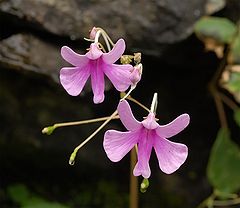Impatiens
This article has a list of references or other websites, but its sources are not clear because it does not have inline citations. (August 2020) |
| Impatiens | |
|---|---|

| |
| Impatiens scapiflora | |
| Scientific classification | |
| Kingdom: | |
| (unranked): | |
| (unranked): | |
| (unranked): | |
| Order: | |
| Family: | |
| Genus: | Impatiens
|

Impatiens is a genus of about 850–1,000 species of flowering plants, widely distributed throughout the Northern Hemisphere and tropics.[1] Together with Hydrocera triflora, they make up the family Balsaminaceae.[2][3]
These plants derives their scientific name Impatiens (Latin for "impatient") and the common name "touch-me-not" in reference to their seed capsules. When the capsules mature, they 'explode' when touched, sending seeds several metres away. This mechanism is also known as "explosive dehiscence"; see also rapid plant movement.
Impatiens have become one of the most popular garden annuals. Hybrids, typically derived from "Busy Lizzie" (the well-known I. walleriana) and the New Guinea Impatiens (I. hawkeri), have commercial importance as garden plants. I. walleriana is native to East Africa,[4] and was bred through selection by Claude Hope. The original series of impatiens bred by Hope was the 'Elfin' series of cultivars, later improved as the 'Super Elfin' series. Double-flowered cultivars also exist. But in tropical islands, such as Hawaiʻi, Busy Lizzie can also become a noxious weed.
References
[change | change source]- ↑ Sunset Western Garden Book, 1995:606–607
- ↑ Common names include impatiens, jewelweeds, touch-me-nots, and, for I. walleriana in Great Britain, "Busy Lizzie", and balsams. "Jewelweed" is used only for Nearctic species, "balsam" is usually applied to tropical species, and "touch-me-not" is used in Europe and North America.
- ↑ RHS A-Z encyclopedia of garden plants. United Kingdom: Dorling Kindersley. 2008. p. 1136. ISBN 978-1405332965.
- ↑ "Impatiens". Archived from the original on 2012-10-31. Retrieved 2012-10-30.
